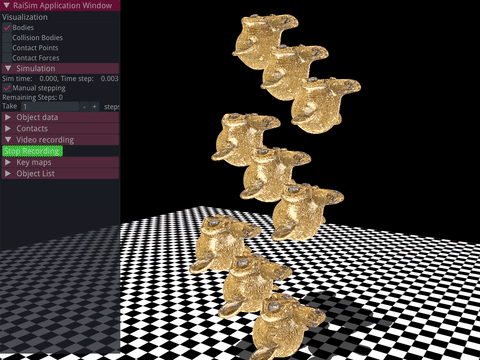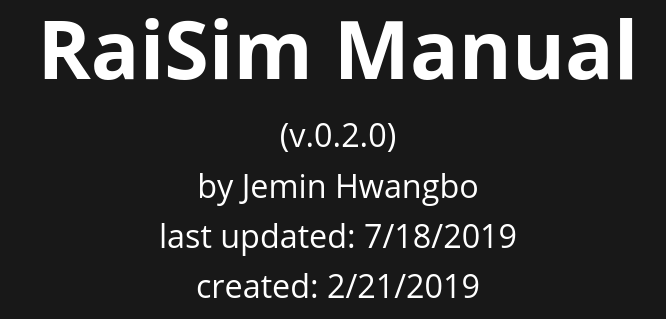You must read the LICENSE before using this software
- As of Nov 12th, you can perform a ray collision test (e.g., to emulate laser sensor). It returns position, normal and the object ID. PLEASE NOTE THAT IT IS NOT A STABLE FEATURE NOW. I WILL MAKE IT STABLE WITHIN A WEEK.
- v0.6.0 introduces new api that lets users create an ArticulatedSystem programatically. Check out the example in raisimOgre!
- In v0.5.0, the error reduction mechanisam of Raisim is significantly improved! Please pull. No API change
- As of v0.4.0, RAISIM can simulate any trimesh (including non-convex ones).

- As of v0.3.0, all "_W" prefixes in method names are gone. For example,
getPosition_W()is nowgetPosition()
Feel free to use the github issues as a forum. Raisim does not have a dedicated forum now.
- Linux only. support ubuntu 16.04 and 18.04 but might work on other distributions
- g++, gcc > 6 (how to install?)
- cmake > 3.10 (how to install?)
- The binaries contain avx2 instructions. If your CPU is 6-year-old or older, it is likely that raisimLib does not work on your machine.
Raisim is a physics engine for rigid-body dynamics simulation. Although it is a general physics engine, it has been mainly used/tested for robotics and reinforcement learning so far. It features an efficient implementation of recursive algorithms for articulated system dynamics (Recursive Newton-Euler and Composite Rigid Body Algorithm). RaisimLib is an exported cmake package of raisim.
- raisimOgre: a visualizer for RAISIM
- raisimGym: a few gym environments using RAISIM
- raisimPy: a (third-party) python wrapper of RAISIM
Please install/save everything locally to prevent any conflicts with other libraries. We will assume that you have a single workspace where you save all repos related to raisim. Here we introduce two variables
- WORKSPACE: workspace where you clone your git repos (e.g., ~/raisim_workspace)
- LOCAL_BUILD: build directory where you install exported cmake libraries (e.g., ~/raisim_build)
raisim depends on the two open-source libraries
- eigen (sudo apt-get install libeigen3-dev)
- png (included in raisim. Automatically installed if you install raisim)
Installing raisim is trivial. Just copy paste lib and include to LOCAL_BUILD, or you can use cmake.
Assuming that you have cloned this repo,
cd $WORKSPACE/raisimLib
mkdir build && cd build && cmake .. -DCMAKE_INSTALL_PREFIX=$LOCAL_BUILD && make install
A short manual can be found here
raisimLib is a cmake package. In your project CMakeList.txt,
find_package(raisim CONFIG REQUIRED)
target_link_library(YOUR_APP raisim::raisim)
When you run cmake of your project, let cmake know where raisim is installed, e.g.,
cmake .. -DCMAKE_PREFIX_PATH=$LOCAL_BUILD
please refer to https://leggedrobotics.github.io/SimBenchmark/
The following code creates raisim::World and simulates a robot, a ball and a flat terrain.
#include “raisim/World.hpp”
int main() {
raisim::World world;
auto anymal = world.addArticulatedSystem(“pathToURDF”); // initialized to zero angles and identity orientation. Use setState() for a specific initial condition
auto ball = world.addSphere(1, 1); // radius and mass
auto ground = world.addGround();
world.setTimeStep(0.002);
world.integrate();
}- raisimOgre: a visualizer for raisim, https://github.com/leggedrobotics/raisimOgre
- raisimGym: RL examples using raisim, https://github.com/jhwangbo/raisimGym
These example videos are generated with raisimOgre (https://github.com/leggedrobotics/raisimOgre)
The policy is trained with raisimGym (https://github.com/leggedrobotics/raisimGym)
Jemin Hwangbo (Robotic Systems Lab, ETH Zurich) is developing and managing raisim with the help from the following contributors:
- Donho Kang, Robotic Systems Lab, ETH Zurich
- Joonho Lee, Robotic Systems Lab, ETH Zurich
For bug reports/feature requests/instructions, use github issues. For private inquiries, please contact us at jemin.hwangbo {at} gmail {dot} com.
Frequently asked questions and their corresponding answers are listed here.
Please, whenever possible, include a standalone executable (which depends only on raisim and raisimOgre) reproducing the issue.
- Ensure that your URDF file does not have unrealistic internal collisions.
- Use raisimOgre to visually inspect your URDF before simulating it (setting the simulation to the manual stepping mode helps). Check if the number of internal collisions in the nominal configuration is zero.
- Raisim adds a spring element to mitigate numerical errors. If your system becomes unstable, it is most likely that it is due to the Error Reduction Parameter (ERP). You can set it using raisim::World::setERP()
The contact related algorithms are published in the below article
@article{raisim,
title={Per-contact iteration method for solving contact dynamics},
author={Hwangbo, Jemin and Lee, Joonho and Hutter, Marco},
journal={IEEE Robotics and Automation Letters},
volume={3},
number={2},
pages={895--902},
year={2018},
publisher={IEEE}
}







